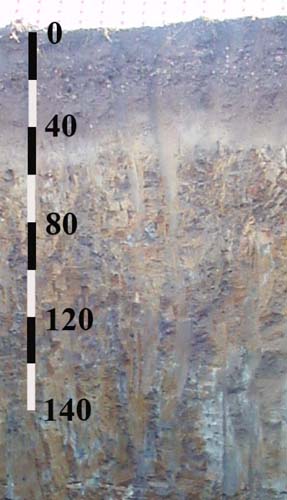EGS254
Location: Banksia Peninsula
Australian Soil Classification: Magnesic, Subnatric, Brown SODOSOL
Map Unit: Fernbank
Previous Site Name: EG254
General Landscape Description: Undulating Rises
Site Description: SE aspect, 7% slope
Native Vegetation: Plains grassy woodland
Geology: Pleistocene alluvial sediments
Soil Profile Morphology:
Surface Soil
| A11 | 0 – 10 cm | Very dark grey (7.5YR3/1); loamy sand; weak fine subangular blocky structure; firm consistence dry; clear change to: |  |
| A12 | 10 – 35 cm | Very dark grey (7.5YR2/1); loamy sand; abundant (50-90%) medium (6-20 mm) rounded quartz and sandstone pebbles; firm consistence, dry; gradual change to: | |
| A2 | 35 – 50/60 cm | Brown (10YR5/3) conspicuously bleached very pale brown (10YR7/3d); sandy loam; massive, abrupt and wavy change to: | |
| Subsoil | |||
| B21 | 50/60 – 110 cm | Brown (7.5YR4/4) with grey mottles; light medium clay; weak medium angular blocky structure; strong consistence dry; gradual change to: | |
| B22 | 110 – 180 cm | Yellowish brown (10YR5/8) with few coarse (15-30 mm) grey (10YR5/1) mottles; sandy clay; massive; clear change to: | |
| C1 | 180 – 240 cm | White (2.5Y8/1) with common (10-20%) prominent fine medium (5-15 mm) dark yellowish brown (10YR4/4) mottles; light clay; firm consistence moderately moist. |
Key Profile Features:
- Strong texture contrast between the sandy top soil and the clay subsoil.
Soil Profile Characteristics:
| - | pH | Salinity | |
Surface soil (A11 horizon) | Strongly Acid | Non-sodic | None1 |
Subsurface (A2 horizon) | Moderately Acid | Non-sodic | Slight 2 |
Subsoil (B21 horizon) | Moderately Acid | Sodic | Moderate 2 |
Chemical and Physical Analysis:
Horizon | Horizon Depth (cm) | pH (water) | pH (CaCl2) | EC dS/m | Organic Carbon % | Total Nitrogen % | Exch. Al ppm | Exch. Acididty meq/100g | Exchangeable Cations | Coarse Sand (0.2-2.0 mm) % | Fine Sand (0.02-0.2 mm) % | Silt (0.002-0.02 mm) % | Clay (<0.002 mm) % | Field cap. % w/w | Wilt. point % w/w | |||
Ca | Mg | K | Na | |||||||||||||||
meq/100g | ||||||||||||||||||
| A11 | 0-10 | 5.5 | 4.5 | 0.19 | 4.8 | 0.36 | 45 | 12 | 4.4 | 1.0 | 0.9 | <0.1 | 54 | 24 | 8 | 5 | 25.3 | 10.0 |
| A12 | 10-35 | 5.6 | 4.7 | 0.06 | 1.7 | 0.09 | 56 | 8.9 | 1.6 | 1.5 | <0.1 | <0.1 | 54 | 26 | 11 | 6 | 17.9 | 4.6 |
| A2 | 35-52 | 6.0 | 5.0 | 0.08 | 16 | 3.5 | 0.4 | 1.9 | <0.1 | 0.2 | 53 | 22 | 12 | 12 | 12.5 | 5.1 | ||
| B21 | 52-110 | 5.6 | 4.6 | 0.32 | 8 | 5.8 | <0.1 | 3.2 | <0.1 | 0.8 | 46 | 10 | 5 | 36 | 25.5 | 14.4 | ||
| B22 | 110-180 | 5.4 | 4.7 | 0.40 | 13 | 4 | <0.1 | 3.0 | <0.1 | 1.0 | 54 | 13 | 3 | 32 | 22.1 | 11.1 | ||
| C1 | 180-240 | 5.5 | 4.8 | 0.78 | 14 | 4.8 | <0.1 | 6.8 | 0.3 | 2.9 | 0.4 | 8 | 50 | 37.5 | 38.3 | 20.2 | ||
Management Considerations
Whole profile
- Plant available water is considered to be very low (estimated at 28 mm) for this profile based on an effective rooting depth of 52 cm. The presence of large amounts of pebbles in the A horizon and the dense clayey subsoil greatly reduce water retention.
Surface (A) horizons
- The surface soil is moderately acidic and, because it is also moderately high in aluminium, lime application may be of benefit.
- Potassium levels in the surface soil are high, but below the surface soil it is at deficiency level.
- The surface horizons have a low nutrient holding capacity (based on the sum of exchangeable calcium, magnesium, potassium and sodium). Organic matter is important for maintaining nutrient and water holding capacity, especially in sandy soils.
- The low wilting points of the surface soils indicates plants will be able to use very light rains when the soil is dry. Due to the low water storage capacity of the surface soils, plants will soon suffer moisture stress unless follow-up rains occur.
Subsoil (B) horizons
- The depth to the clay would have little influence on plant growth as it occurs too deep in the profile.


